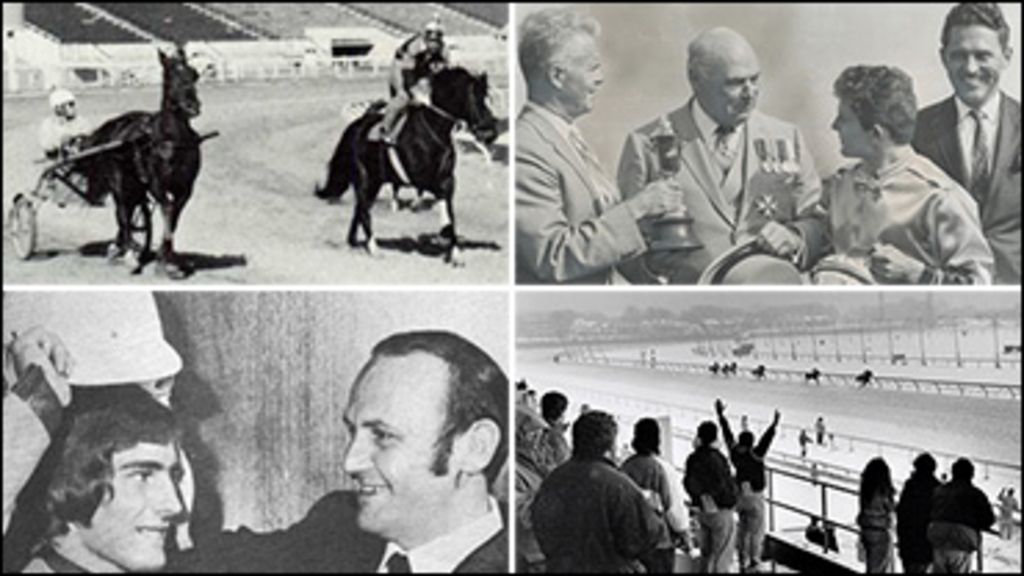
 In this week's 'Rewind,' Robert Smith discusses the links between Standardbred and Thoroughbred racing or perhaps the scarcity of interaction between the two groups. His piece which is somewhat pictorial in nature features a number of old photos including several showing some of the times when the two sport's participants got together.
In this week's 'Rewind,' Robert Smith discusses the links between Standardbred and Thoroughbred racing or perhaps the scarcity of interaction between the two groups. His piece which is somewhat pictorial in nature features a number of old photos including several showing some of the times when the two sport's participants got together.

Standardbreds and thoroughbreds, traditional rivals, are rarely to be found occupying stall space at the same track. However, they are currently living in harmony at Stampede Park in Calgary, Alberta. A total of 655 thoroughbreds and 600 harness horses are well into spring training, with the runners utilizing the cushioned inside of the track, and the pacers and trotters legging up on the outer hardened surface. (Quote and photo courtesy of Hoof Beats, May 1978)
Down through the years it seems that despite the similarities of the two sports which would seem most likely to be closely related and interact have in actuality had relatively little to do with each other. I guess you would say they were "odd bedfellows." To put it mildly, the two share very little in common. While they often raced at the same tracks and were served by some of the same support personnel, they did not share too much else. While a few people had an interest in both breeds, for the most part racing fans had a definite preference and attended one or the other but not usually both.
Based on my own personal experience (which doesn't count for much) I have been interested in the harness breed for as long as I can remember. My experience with the beloved runners consisted of watching four live races about 45+ years ago. It may not have been a fair trial but the fact that I never had an interest in going back again might tell the story. I do enjoy tuning in on say the Kentucky Derby every May and watching the race as well as the pomp and frills that surround it, but two minutes after the TV is turned off I have already forgotten who won it!
In the so-called old days of harness racing when most if not all of the competition took place at rural fairs the racing program often included not only harness but also horses being ridden. I think the latter were often not officially thoroughbreds but any horse with some speed, stamina and a willing rider. When Greenwood celebrated its 100th anniversary in 1975 a program that included both harness horses and thoroughbreds was part of one Saturday program. I remember from an earlier Rewind that Mr. David Aziz commented that he recalled a Jockey named Lloyd Duffy obtained a temporary driver's licence and drove a horse from Carman Hie's stable on that day.
While the numbers are not large, there have been a few individuals who have participated in both Standardbred racing and on the Thoroughbred side. I have assembled a short list of those I am aware of and welcome the readers to add to the list. Also a few of the pictures show the combination. This abbreviated list in alphabetical order would include the Armstrong's of Armbro fame who once dabbled in T'Breds, Bill Galvin, who groomed and wrote about both kinds, Sandy Hawley (as a world class jockey turned Standardbred commentator), Rene Kierans with close ties to both and Norm McKnight Jr., who mainly trained pacers and trotters but later switched to the bangtailers. Going way back in time the great Nat Ray, who won the first ever Hambletonian in 1926, was also a jockey and steeplechase participant early in his career.
When the late Marie Hill wrote her book which was titled "The Horseman From Alberton" she revealed an interesting aspect of the career of the famous reinsman Joe O'Brien, the subject of her writings. I will repeat her passage as it appeared in her book as stated by Mr. O'Brien.
"One regret I have is that I would liked to have trained one or two Thoroughbreds. Train them my way. I can't help but think that Thoroughbreds could be trained a lot better than they are in most cases. There are only a handful of good T'Bred trainers in the business. I would say that 90 percent of them really don't know how to train a horse. The hard part is that even a good trainer, weighing 170 pounds or so can't do the training themselves. I'd like to break the runner to a jog cart and train them up to a certain point. I don't believe there would be so many problems with soundness and bucked shins. Hunter Moody used to break them to a jog cart. By the second day they had harness on and they would have hopples too. He had a knack for getting them going fast quick."
The following are a number of old photos, each accompanied by a short narrative. They all relate to some aspect of the theme of today's story.
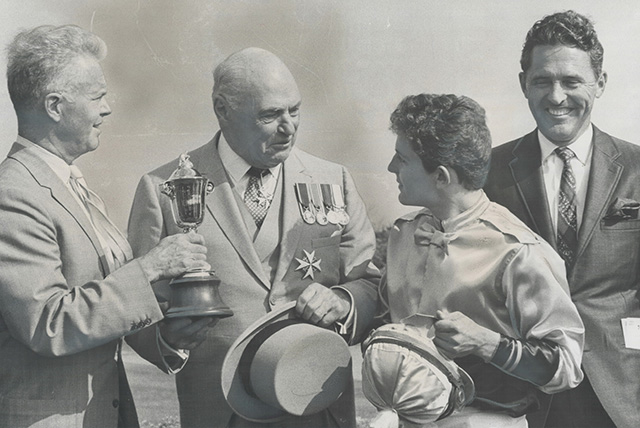
The Hon. W. Earl Rowe, Lt. Governor (second from left) long a proponent of harness racing and a distinguished breeder, trainer and driver himself among other things, was also involved with the Thoroughbreds. He is pictured here in the winner's circle on Queens Plate Day in 1968. From left is co-owner Max Bell; Mr. Rowe; winning jockey Wayne Harris; and Roy Johnson, trainer of the winning horse Merger (not to be confused with a Standardbred of the same name who won the 1982 Jug for John Campbell)
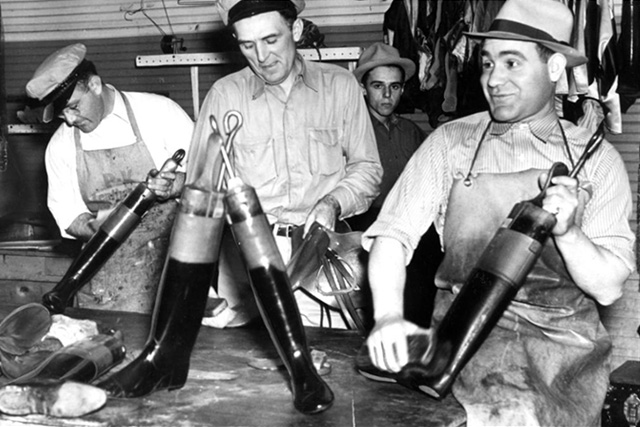
Apparently thoroughbred jockeys are rather particular about their footwear. The above photo taken many years ago at Aurora Downs in Chicago shows valets working on a raft of jockey's boots for that day's races. The job reportedly took just a mere four hours each day to complete. (Chicago Tribune)
-640px.jpg)
Back in 1964 famous Argentinian-born Thoroughbred trainer Horatio Luro made a trackside presentation to driver Allan Walker following his victory with the trotter Canadian Intrusion in that year's Fort George Trot at Mohawk Raceway (Harness Horse)
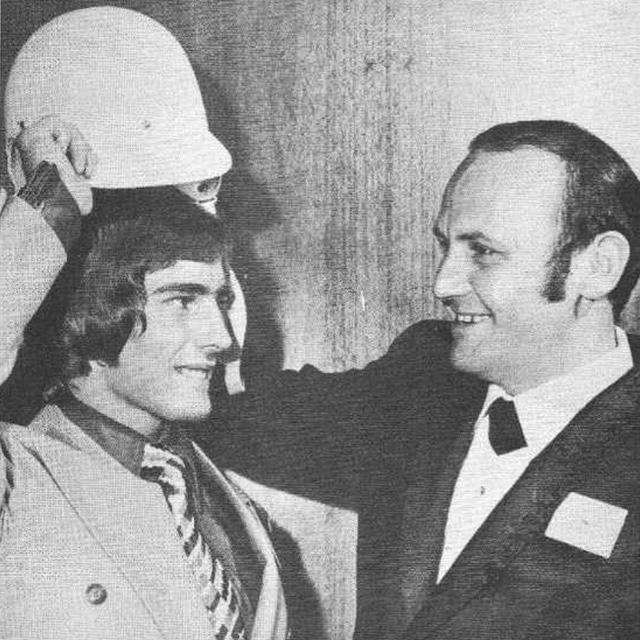
Feb. 1971 - Herve Filion on the right, is shown adjusting his driving helmet on North American Thoroughbred champion Jockey Sandy Hawley at a sport's celebrity dinner in Toronto. Filion, who was 31 at the time, was listed as the current world champion harness driver based on his 486 wins the previous year. Herve at the time had 2,917 lifetime wins to his credit, placing him second all time behind Wm. "Billy" Haughton, who had 3,311 visits to the charmed circle. Hawley was just 21 at this time.
In the upcoming year, a series of races to determine the winner of that year's International Driver's Championship was to be held at various U.S. and Canadian Tracks including stops at Greenwood and Montreal's Blue Bonnets during May. The tour was to visit 10 tracks that were scheduled to host the HTA competition. In addition to Filion who was chosen to represent Canada and Wm. Haughton of the U.S., there would be drivers from sevral other Countries such as Italy, West Germany, New Zealand and possibly France. This was to be just the second ever such competition. (Photo: The Standardbred Record; Orangeville, Ont.)
Some 40-plus years after this picture was taken, it is interesting to note that Sandy Hawley became a part of harness racing, serving as a commentator on The Score's television coverage from Mohawk and Woodbine. Hawley, whose actual name is "Desmond Sanford", was born in Oshawa, Ont. and reportedly first pursued a career as a plumber before becoming Canada's most accomplished jockey.
Hawley has had the lifelong reputation of being a gentleman and a man of honour, an attribute that far outweighs all of his statistical achievements. Welcome to our side.
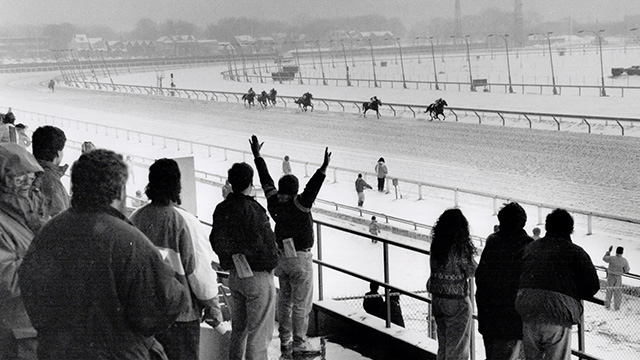
For many years the two breeds shared the same facility at Greenwood Raceway. The above scene shows opening day in 1992 when over 11,000 fans braved the weather to see their favorites in action at the venerable old lakeside track. While the pacers and trotters often endured inclement weather it is not a customary scene for the runners.
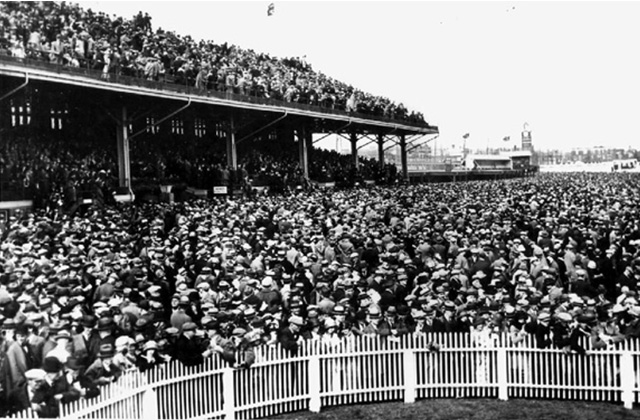
A large crowd gathers at the fabled Woodbine Track in downtown Toronto. Photo courtesy of Toronto archives


At Grand Circuit 1974 we
At Grand Circuit 1974 we witnessed a Trotting Under Saddle exhibition race. James Walford won in 2:06:1 riding Varioca M. John Leblanc was second on Wes Coke's Sun Bo. Other jockeys included Sandy Hawley, Lloyd Duffy and Hugo Dittfach. The race looked awkward with the jockeys bouncing hard up and down in time with the trotting gait. They seemed to have no ill effects as we saw them later at a party in the dining room, probably arranged by Jim Lampman. There were 10 starters for a purse of $4,000 which was decent for that era.
I'm with you Robert when you
I'm with you Robert when you suggest two minutes after the Kentucky Derby you've forgotten the winner. I think I've watched the runners live five times in my life and there are many weeks I've watched the pacers five times or more in the seven days. A memory from my days as a young lad watching racing at fairs. Several times the pacers/trotters were co-featured with "chariot races." I'm assuming the horses (usually two but sometimes just one) were old thoroughbreds pulling contraptions that were built around large metal barrels and a wide assortment of wheels, and to my eyes, didn't seem even remotely safe. Some of the chariot drivers were adorned with Roman Centurion costumes, although I think old living room drapes were usually the origin of these outfits. Mildly entertaining but nothing to compete with the beauty and grace of the standardbreds.